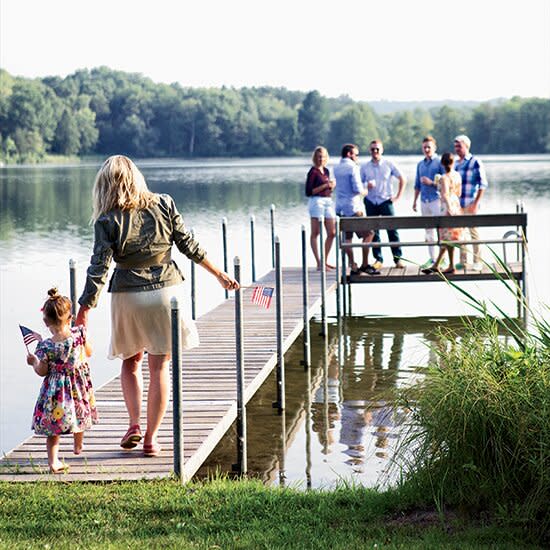How Minnesota's First Sons Are Going into Food
- Oops!Something went wrong.Please try again later.

The Fourth of July parade in every small Midwestern town has the same cast of characters: children holding miniature flags; Jaycees and VFW volunteers giving out candy; and pretty girls—who for one afternoon are Corn Queens or Strawberry Princesses or lesser members of the royal produce family—waving froma fire engine. A politician is always there, too, smiling and pressing the flesh, and in Minnesota, a good deal of the time, that politician is the governor, Mark Dayton.
"My dad is a great parader," says Andrew Dayton as he sips a gin rickey in his family's backyard. "He'll do three a day," adds Andrew's brother, Eric. "He loves them. His trick is to try to get the kids to squirt him with water guns. It really helps with the sun. It can get so hot out there."
While their father is out parading, the Dayton brothers—who own The Bachelor Farmer, a New Nordic restaurant in Minneapolis—enjoy the Fourth a different way, by hosting a cookout at their family's lakeside place on the prairie outside the city. Their quiet get-together is its own kind of celebration—of roots: America's, Minnesota's and their own.
To be a member of this distinguished family means to successfully build upon the work of the generation before. George D. Dayton, a real-estate impresario, purchased a dry-goods store in Minneapolis in 1902. The next two generations helped him expand the shop into Dayton's, the Minnesota department store. The family launched over a dozen more, and in 1956 they built Southdale, the world's first shopping mall. Six years later, they founded Target. Mark Dayton, great-grandson of George, went into politics, was elected one of Minnesota's US senators and is now its governor. He married Alida Rockefeller, a descendant of another illustrious family, then Eric and Andrew came along.
In 2008, the brothers (Eric with an MBA, Andrew with a law degree) followed in their great-great-grandfather's footsteps and built their own kind of department store. They converted a 15,000-square-foot fur-and-hide warehouse downtown into a three-in-one food and shopping destination. On the basement level is the speakeasy-style Marvel Bar, and on the main floor is the menswear boutique Askov Finlayson, which sells Paul Bunyan–goes–hipster clothes like sturdy canvas pants for canoeing and knit pom-pom hats reading NORTH—a cold-climate version of the ironic trucker hat. Eric tells a humbling story about the store: Soon after it opened, a customer wanted to return some socks. Unable to log in to the point-of-sale system, Eric reached into his wallet and refunded the woman himself. Minus the technology, any number of Dayton ancestors could tell the same tale.
Also on the main floor of the former warehouse is The Bachelor Farmer. The name is a hat-tip to a conceit on the radio show A Prairie Home Companion about the world's most timid eaters: Minnesota's Norwegian bachelor farmers, who eat their own potatoes every day, and deem ketchup an aggressive spice. Although cheeky, the restaurant's name acknowledges the traditional food of the millions of Scandinavians who settled in America's heartland. When The Bachelor Farmer opened, the chef, Paul Berglund, offered Swedish meatballs, perhaps Scandinavia's most ubiquitous culinary export. The dish was a hit with Governor Dayton: "I ordered them the first 14 times I ate there," he says. "Then Eric and Andrew took them off the menu and jokingly told me it was to force me out of my comfort zone."
Berglund currently focuses on whole-hog butchery. Every week, he breaks down two Red Wattle hogs and uses them in the pork-fat turnips, the headcheese with toast and butter and the now-famous Monday-only pork chops. Thick-cut, they are brined with carrots, onions, celery, cloves and juniper berries for two days, then grilled.
When it's time for those pork chops to come off the grill at the Fourth of July party, a round of applause erupts from the guests at a table already covered with bowls and platters full of the vegetables that grow well in northern lands. There are crunchy carrots, cucumbers and radishes pickled in a vinegary broth flavored with dried mushrooms. Pickled flavors are everywhere in Nordic cuisine, and they find their way into many of the dishes on the table. Skewers of bacon-wrapped cherry tomatoes and oyster mushrooms are brushed with a dill pickle relish; lightly fried fish is pickled overnight and served with rye bread and crème fraîche. Even potato salad gets a sprinkle of vinegar; fresh horseradish adds bite.
This is not the cuisine the Dayton brothers were raised on. Instead of New Nordic, they grew up gorging on spaghetti (a favorite way to load up on carbs before hockey games) and Oreo ice cream from Sebastian Joe's, the local ice cream shop that gives steep discounts when the temperature drops. In high school, Eric worked as a line cook at an ambitious local restaurant and became enamored with the camaraderie of the kitchen. One night, his work buddies took him to eat at the Minneapolis outpost of Marcus Samuelsson's haute Swedish restaurant Aquavit. "Samuelsson brought us dish after dish," Eric says. "Everything was so good."
About 10 years later, the Dayton brothers are the culinary heirs to that now-shuttered restaurant, picking up where Samuelsson left off and serving an adapted, contemporary version of Nordic cuisine at both The Bachelor Farmer and here on the prairie where they celebrate Independence Day. But there's one thing missing from this scene: fireworks. Eric plans to watch some with his wife, Cornelia, and the youngest Dayton, baby Hugo, at their home in Minneapolis. If it gets cold, he might tuck Hugo into the sweater a volunteer knit for Eric back when he was a baby out parading for his dad's first senate campaign. The little sweater is gold and blue and it says DAYTON on the back. It is a family heirloom, a tangible reminder of the most important legacy each generation inherits from the previous one: its story.
